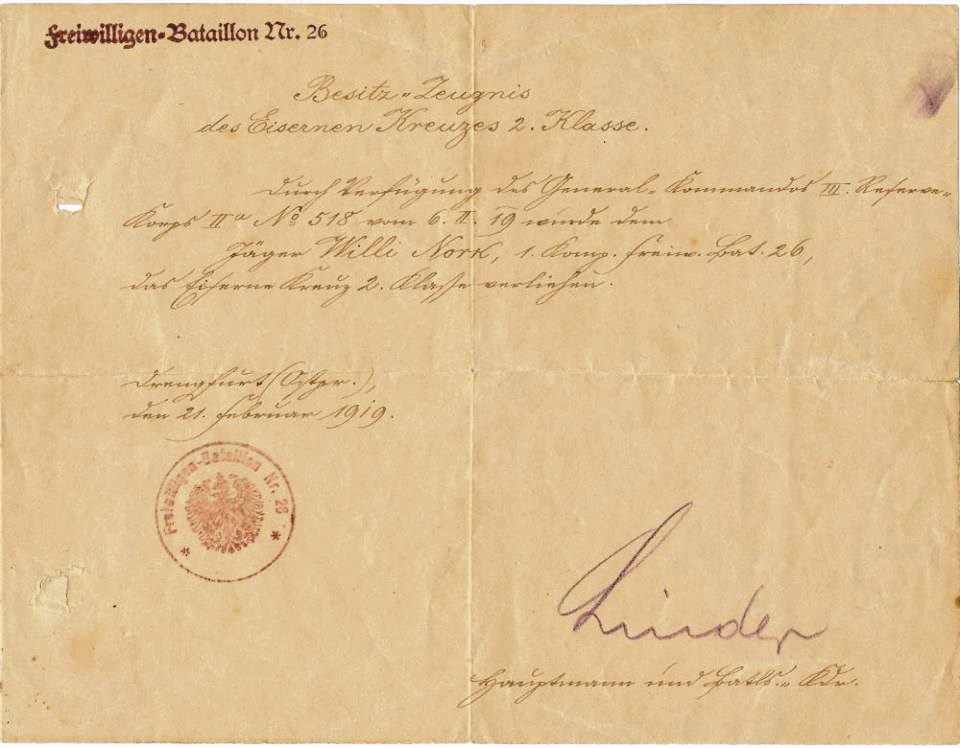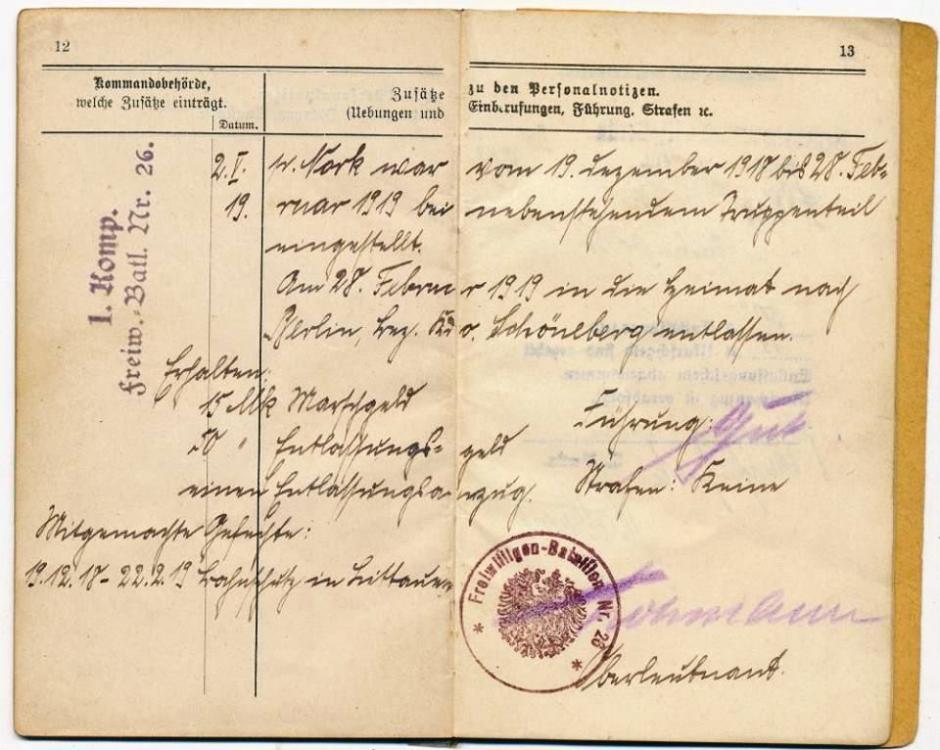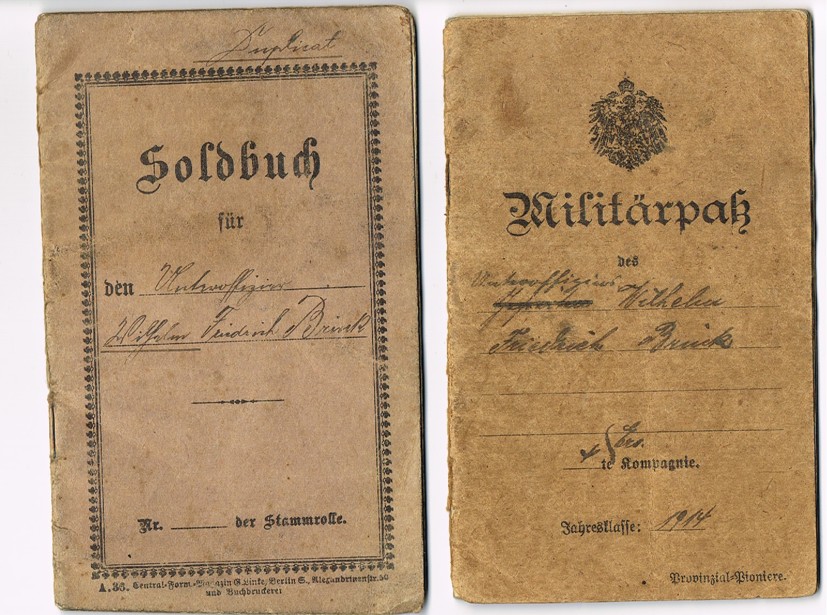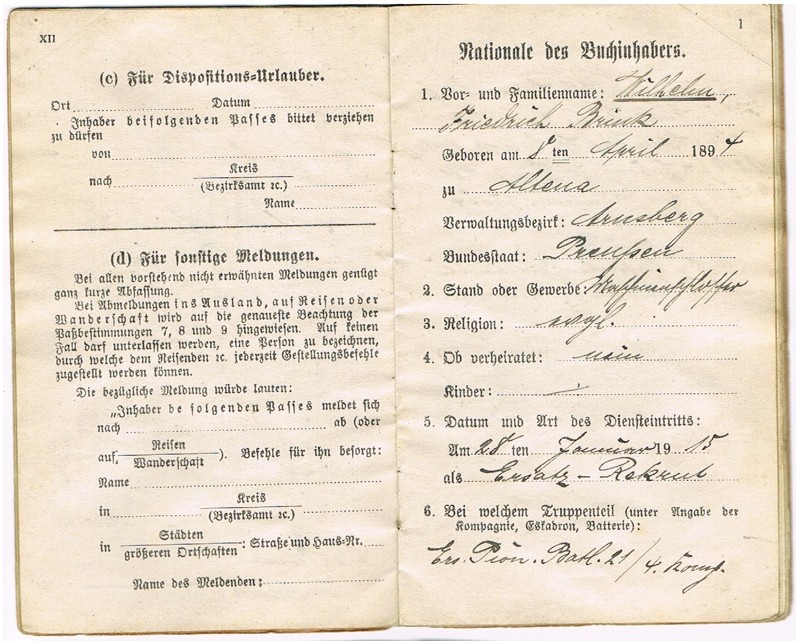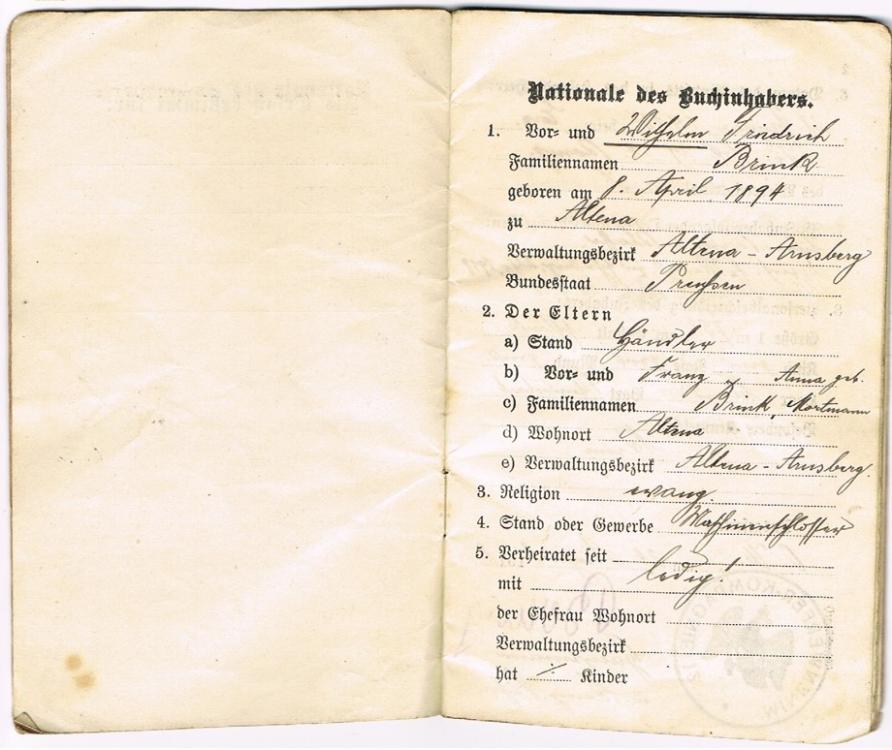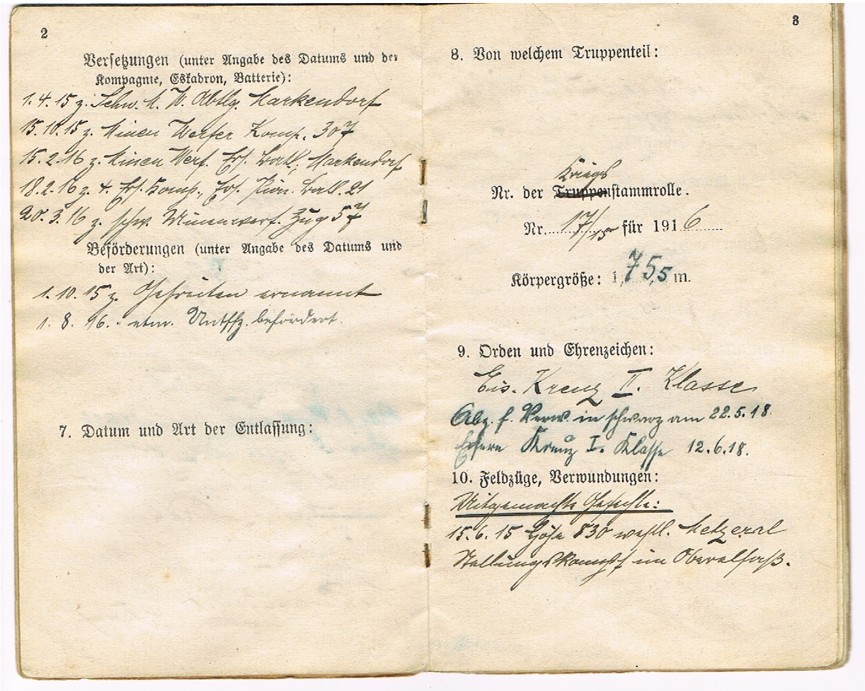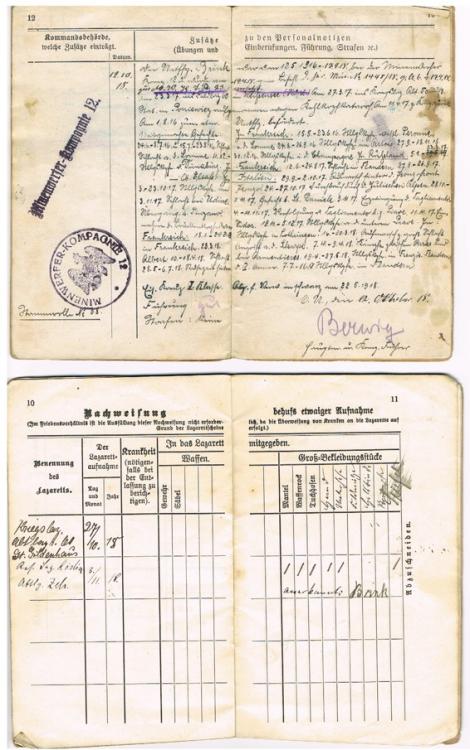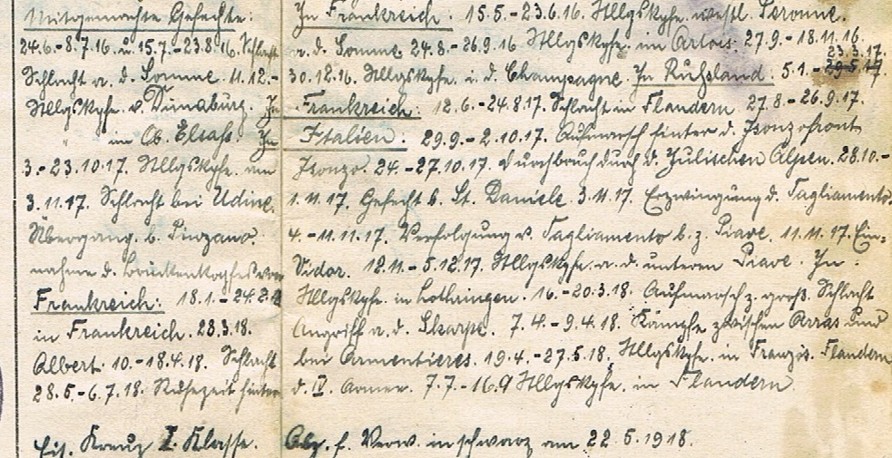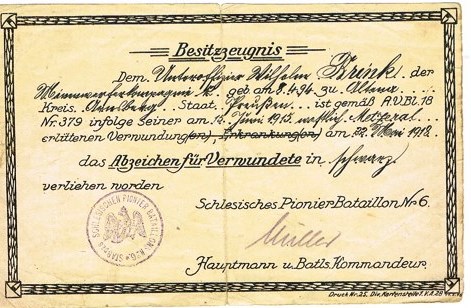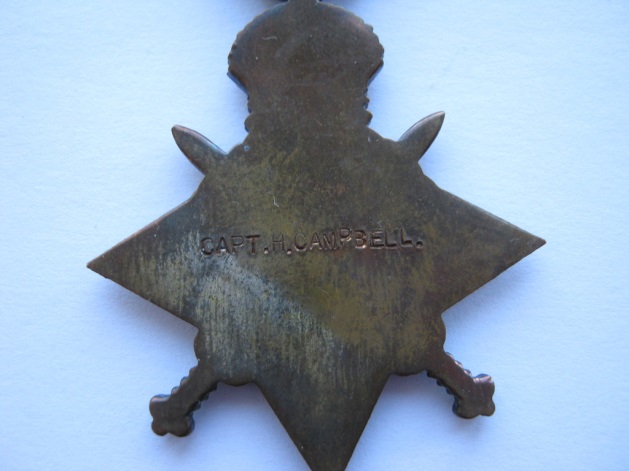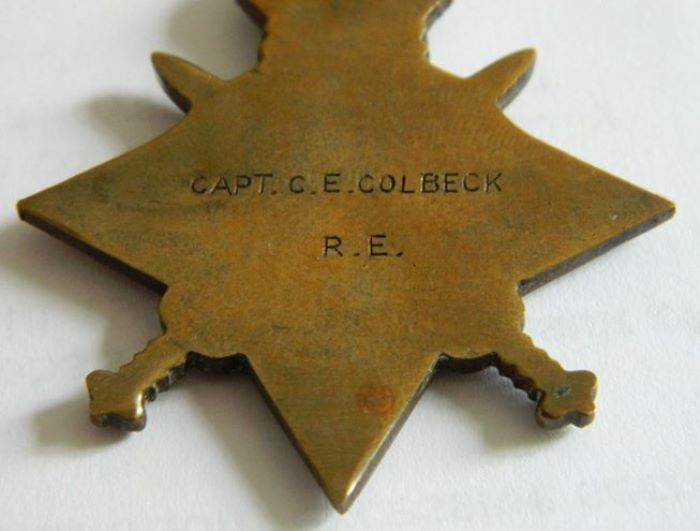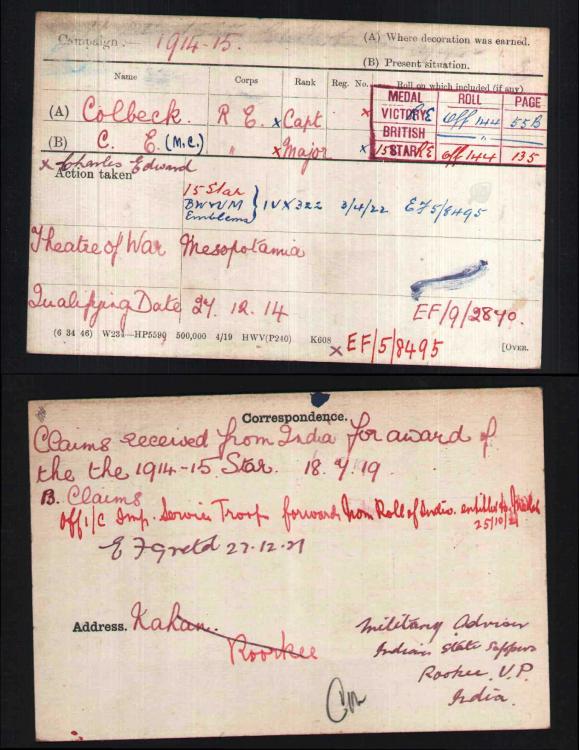-
Posts
2,470 -
Joined
-
Last visited
-
Days Won
2
Content Type
Profiles
Forums
Blogs
Gallery
Events
Store
Everything posted by dante
-

Freiwilligen Bataillon Nr. 26
dante replied to dante's topic in Germany: Weimar Republic & Deutsche Freikorps
Dave thats great, gives me something to work on, thanks -
Try as I might I cannot find any note of this Bataillon, he was originally Jäger Regt zu Pferde Nr 9, any help gratefully received, thanks, Paul
-

Single British War medal to a rogue
dante replied to dante's topic in Great Britain: Orders, Gallantry, Campaign Medals
http://gotha2.blogspot.com/2017/07/qui-etaient-ces-maries.html I hope this time a correct photo of Lucy -

Single British War medal to a rogue
dante replied to dante's topic in Great Britain: Orders, Gallantry, Campaign Medals
-
Great War British war medal and Victory named CONST. D. MARSH E. AFR. POLICE entitled to 1915 trio and the Kings Police medal (KPM). David Marsh, 1st Class European Constable, East African Police awarded the Kings Police Medal in 1919 According to the Kenya red book (1922) he was an Inspector in Mombasa and left the police in 1922. He appears to have served in the Sunderland Borough Police (Hebburn or Yarrow) There is no note of him in the History by Foran Can anyone point me in the right direction for archives or records, as ever thanks. Paul
-

SAS Wings...
dante replied to Chris Boonzaier's topic in Great Britain: Militaria: Badges, Uniforms & Equipment
The original badge shown is a restrike of the British tropical SAS wings. These wings were manufactured but never worn, -
Nice tunic, un-named but a trawl through Canadian archives throws only one possibility Technical Sergeant George Washington FERRELL DFM, Air Medal FERRELL, Sergeant George (R117536) - Distinguished Flying Medal - No.103 Squadron - Award effective 2 June 1943 as per London Gazette dated 2 June 1943 and AFRO 1459/43 dated 30 July 1943. American in the RCAF. Born 14 October 1914 in Trenton, New Jersey. Home in Belleville, New Jersey. Electrician. Enlisted in Montreal 12 July 1941 and posted to No.1 Manning Depot. To No.4 WS, 27 September 1941. Promoted LAC, 29 October 1941. To Trenton, 8 June 1942; to No.6 BGS, 18 July 1942; graduated and promoted Sergeant, 28 August 1942. To “Y” Depot, 29 August 1942. To RAF overseas, 26 October 1942. Promoted Flight Sergeant, 29 February 1943. Discharged from RCAF, 28 July 1943. Cited with a Sergeant K. Breckon (RAF, awarded DFM). RCAF photo PL-22188 (ex UK-5990 dated 4 November 1943) taken when he was a Technical Sergeant with American forces, after investiture at Buckingham Palace. RCAF photo PL-22190 (ex UK-5992 dated 4 November 1943) shows Flight Sergeant D.C. Moore (George Medal, Durham, Ontario) chatting after investiture with other recipients, notably (on his left) Technical Sergeant G.W. Ferrell (DFM, Belleville, New Jersey). Sergeants Breckon and Ferrell were pilot and mid-upper gunner, respectively, of an aircraft which attacked Dortmund on night in May 1943. On the return flight the aircraft was subjected to repeated attacks by an enemy fighter. Although his turret was rendered unserviceable early in the combat, Sergeant Ferrell operated it manually, at the same time giving his captain a commentary on the attacker's movements. In spite of his difficulties Sergeant Ferrell eventually delivered a well directed burst of fire and shot the attacker down. Soon after crossing the enemy coast one of the bomber's engines caught fire and became unserviceable while a little later another engine ceased to function. Despite this, Sergeant Breckon flew on and, although a third engine became unserviceable as the English coast was reached, he succeeded in gaining an airfield where he executed a masterly landing without the aid of flaps. These members of aircraft crew displayed great skill, courage and determination in circumstances fraught with great danger. NOTE: Public Record Office Air 2/4974 has recommendation for a CGM (Flying) drafted 29 May 1943 by the Commanding Officer of No.103 Squadron. This award was supported up to the level of Air Officer Commanding, No.1 Group, so it was presumably downgraded at Bomber Command Headquarters. He had flown only one sortie (five hours ten minutes). During the attack on Dortmund on the night of 23/24th May 1943, Sergeant Ferrell, a Canadian, was mid-upper gunner of a Lancaster aircraft. After leaving the target, his aircraft was attacked by an enemy night fighter which carried out nine separate attacks in all. On the third attack both the mid-upper and rear turrets were rendered unserviceable almost simultaneously. Undaunted by the extremely hazardous position in which he was thus placed, he showed exceptional courage and determination in continuing coolly to warn his captain of each impending attack and giving him evasive directions at the same time endeavouring to ward off the attacks by manipulating his turret manually, rotating it by hand to whatever side the attack was coming from, and opening fire as best he could under these extremely difficult circumstances. On the sixth attack after his turret became unserviceable he got the fighter into his sights and opened fire, whereupon the fighter went into a steep dive and was seen to crash on the ground. Sergeant Ferrell not only showed exceptional skill as a gunner, but displayed outstanding gallantry and coolness in the face of danger and by his fearless determination and presence of mind extricated his crew from a perilous situation. He has set a high example for all to follow, and I have no hesitation in strongly recommending him for the immediate award of the Conspicuous Gallantry Medal. Public Record Office Air 50/292 has the following Combat Report for the night of 23/24 May 1943, Lancaster C2/103, W4325: Returning from a raid on Dortmund on the night of 23/24 May 1943, while flying at 18,000 feet, position 5205N 0640E, visibility good, about 8 to 10 miles with moon practically full on port quarter up, the time 0218 hours, the rear gunner of Lancaster C.2 {Sergeant Lefort] sighted a Ju.88 on green quarter down, 350 yards range. The rear gunner gave instructions to the pilot to make a diving turn starboard, which was carried out, and as this evasive action was being taken, the rear gunner and mid-upper gunner [Ferrell] opened fire but observed no hits. The fighter was unable to get a burst in on this attack, so broke off on the red quarter down, whereupon the pilot from instructions from the rear gunner resumed course and the Ju.88 positioned himself on the port quarter up about 400 yards away. When the fighter committed himself to the attack once more, the rear gunner again gave orders for a diving turn to port, which the pilot carried out immediately and the rear gunner and mid-upper opened fire, observing hits, and once again the fighter was forced to break off the attack without opening fire, whereupon the pilot resumed course after receiving instructions to do so from the rear gunner, and the Ju.88 positioned himself on the green quarter up about 450 yards. When the fighter committed himself to the attack once more, the mid-upper gave instructions to the pilot to make a diving turn to starboard, which was carried out; the Ju.88 opened fire from 200 yards for about two seconds and put both rear turret and mid-upper turret unserviceable, but was unable to follow up attack and broke away down to port, whereupon the pilot resumed course after receiving orders from the mid-upper to do so and the Ju.88 positioned himself more on the red quarter down about 350 yards away. The mid-upper, fearing that the intercom might be put unserviceable, gave the skipper orders to corkscrew continually while continuing on course, which was carried out. The Ju.88 attacked once more and his cannon shells hit the starboard main plane and rudder. The fighter broke off the attack at 150 yards, diving down on starboard quarter and back up, position on the green quarter up about 300 yards away, and attacked once again from that position. In the meantime the mid-upper, finding his turret unserviceable, put it in hand rotation, and rotating the turret by hand to the side from which the attack was coming, while the rear gunner with one hand and elevator and depressed the gun, and with the other opened fire, but found it difficult to make a correct allowance. The Ju.88 altogether made six attacks from alternate sides and the mid-upper continued to rotate his turret from side to side, opening fire as best he could each time. On the sixth attack after the turrets were unserviceable, the fighter ran through the mid-upper’s cone of fire and was seen to heel over on his side, dive straight down and was seen to crash on the deck and burst into flames by the rear gunner, wireless operator and engineer. There were no searchlights cooperating with fighter and there was no flak. Pre-war Ferrell served in the Merchant marine, he died in 1969
-
Jerry, tough one, with so many copies, as for ebay, I would stay away until you have a good handle, there are some reasonable books on the subject and that would be a good way forward
-
Single Victory Medal....in the dying embers of the Great war Frederick Justin Schrader was born in Negumbo, Ceylon on the 26 Jun 1892 to George Archibald Schrader and Thomasin Lily Martin. I have been unable to ascertain what Fred did before the war and how he came to be in England to enlist Fred enlisted in the artists rifles and attended officer training at Devonport, commissioned in February 1918 into the Devonshire Regiment, he left for France the 7th September 1918 on an American troopship with five other newly commissioned officers under the command of John Boynton "J. B." Priestley, (Order of Merit; 13 September 1894 – 14 August 1984, English novelist, playwright, scriptwriter, social commentator, and broadcaster). Priestly comments on the journey (and mentions Fred) in his literary reminiscences, Margin Released, all destined for the 16th Battalion, The Devonshire Regiment. Priestley comments that on Arriving at Rouen 2ND Lt Cox, Schrader and Reed, were left to be casualty replacements and Priestley, Farrer and Machon marched towards the front line, arriving on the 16th September, on the 18th September the Battalion went over the top, during the attack on the “Red Line” South East of Ronssoy, Priestly and Machon were wounded and Farrer dead. Some days after Cox, Schrader and Reed replaced their friends on the line. Fred was discharged from the 3rd Battalion on the 22 April, 1920 He returned to Ceylon 1919 and was a tea and rubber planter until his retirement. His race was Dutch Burgher. He married, at St. Stephen’s Church, Negumbo on 23/06/1920 Hope Siebel Foenander, born 03/04/1889, daughter of Harris Julian Foenander; He passed away on 30 Dec 1966
-
Single 1915 Star, Herbert Campbell was born 21 April 1875 and was brought up He came to Winchester Collage in the summer of 1888 and left in the summer of 1893, followed by his brother William Orr Campbell (DSO, 13th RWF) in 1891. They were the sons of William H Campbell and Augusta Biddulph OF Brewoods Close, Cookham Dean and 30 Lancaster Gate, Hyde Park . Herbert was a member of the Debating Society but his speeches aren’t recorded. There is some confusion as to what University he went to some documents have him at New others Magdalen College, Oxford but he is registered on the war service of Oriel College , Oxford (although they record his service as Salonika, where as he only served in France). On leaving he was employed within the Foreign Office as secretary to HM Consul General to Norway in 1899, then a member of the British Mission to reorganise the Greek Navy 1911-1913. Reference: ADM 1/8648/228 Description:British Naval Mission to Greece Date: 1923 Held by: The National Archives, Kew Legal status: Public Record(s) Closure status: Open Document, Open Description Mission was 1912-1913, during the Balkan Wars In 1913 He was awarded the Chevalier of the Royal Order of the Redeemer as the Secretary to the Head of the Mission, Paymaster-in-Chief George Barnard Townesend, R.N. In 1911 he was Elected Fellow of the Royal Geographical Society and noted on the 1911 census as being of "independent means" . In 1915 he then joins the 17th Battalion Royal Welch Fusiliers in 1915, first as Lieutenant, then promoted to Captain. He was Staff Capt D.A.A.G, with the 113rd Infantry Brigade and mentioned in Haig’s despatches in 1917, He remains "general list" staff captain until 1918 when he re-joins his regiment. (Note Oxford University war service has him serving in Salonika, which is wrong, he only served in France) He was awarded the Military Cross in the 1918 New Year’s honours list. At some point he moved to Cyprus on account of rheumatism Herbert was an expert in genealogy, especially that relative to the Duntroon Campbell's, having had numbers of articles published in The Genealogist in the 1920's. He also authored the "The Campbell's of Duntroon and Their Cadets" 1913 He is mentioned on the ‘keep’ board bearing the names of Wykehamists who passed through an old farmhouse known as the ‘Winchester Keep’ near to the front line at Laventie. Herbert’s name is recorded on one of the boards and this is now kept here at the school. Herbert wrote to the school magazine about the design and location of our proposed war memorial. He died in Cyprus in 1931 (I have yet to find an obituary).
-
Single “engraved” 1915 Star, with the correct details to Captain Charles Edward Colbeck Royal Engineers Later awarded the Military Cross for the defence of Kut-al-Amara while serving with an Indian Imperial Service company, the Sirmoor Sappers and Miners and later was the driving force in developing a modern “Greek Fire” for defending Britain’s beach defenses before WW2 Being more than interested in the “Shingle Street” conspiracy I was surprised to find Colonel Colbeck moving to the area just before the war…I shall leave you to ponder if it is is more than a coincidence. 1881; was born on the 11th April 1881 in Harrow, the son of Mary and Charles. He had one brother and two sisters. His father Charles was a master at Harrow (died 1903), 1895; Charles Edward entered Harrow (Midsummer) 1895 as an Entrance scholar, became a Monitor in 1899 and passed for RMA Woolwich in 1898 but did not enter Winston Churchill was at Harrow 1888-1892 1900; He became an Engineering student Royal Indian Engineering Collage at Coopers Hill 1903; Commissioned 1st September 1903 1906; Promoted Lieutenant 1911; Served Royal Engineers attached to the 1st K G O Sappers & Miners and noted as attending the 1911 Delhi Durbar as Special Service Officer to the Maharaja of Sirmoor 1914; Assistant Inspector Imperial Service, Sappers 1914; 27th August, 1914 promoted Captain as Senior Special Service Officer to the Sirmoor Company, Sappers and Miners belonging to the Maharaja Amar Parkesh of Sirmoor 1914; 17th November deployed with the company to Mesopotamia 1915; In his Book in Kut with the Sixth Division and Captivity, Major Sandes MC RE mentions Major Colbeck three times; First is building a bridge a mile downstream then moving it closer to Kut; “While these three boats were being placed in the bridge I went down again to the two long sections of gissara (type of boat used in Turkish and Arab bridges). bridging moored by Captain Colbeck, R.E., above the fort, where we cut loose two more gissaras and brought them up also to be placed in the new bridge. This was very slow and laborious work”. The third mention is a trench raid; "It was evident that the Turks intended to assault the fort, and, by December 17th, the garrison feared that the enemy had begun mining from his sapheads. Our sappers had sunk a shaft opposite the east point of the fort and another in the north-east bastion, and had run-out some short listening-galleries. As water was encountered only 13 feet below ground-level there was no fear from deep Turkish mines, but to ascertain if hostile mining was actually in progress and to check the enemy, two sorties were planned for the early morning of December 18th 1915. To commence with, two parties of Sirmoor Sappers crept out after dark on December 17th and cut two ways through the remains of our barbed wire, and stacked light bamboo pyramids of barbed wire close at hand ready to close the openings if required. A red Verey light (part of our aeroplane equipment) was to be fired as a signal for the sorties, whereupon our guns were to shell the Turkish support trenches, and all the machine guns and rifles in the fort were to add their quota to the storm of bullets. The sorties were timed to start an hour or so before dawn, as soon as the moon went down. No. 1 Sortie Party (fifty men of the 103rd Mahratta Light Infantry) was led by Lieutenant Hinds, 103rd Mahrattas, with four bombers from the 1st Oxford and Bucks Light Infantry, accompanied by Captain C. E. Colbeck, R.E., with six Sirmoor Sappers carrying explosives for destroying mine-shafts. This party dashed for the nearest hostile sap from the north-east bastion. No. 2 Sortie Party, similarly composed, but with men from the 119th Infantry and led by Lieutenant Haddon of that regiment, with Jemadar Durga Singh in charge of the sapper party, rushed out at the same time from our trenches outside the east point of the fort. The Turks were taken completely by surprise while at work and were bayoneted before they could get their rifles. The sortie parties then worked down the Turkish trenches and saps with bombs, sending back about a dozen prisoners and a quantity of rifles and entrenching tools. A fierce fight ensued with a party of Turks trapped at the third sap opposite the north face, but this sap was eventually cleared by bombing. Five sapheads were next examined and found to show no trace of mining work, so the two sortie parties returned to the fort just before dawn on December 18th, having killed about forty of the enemy and with only one man of the two parties slightly wounded. The garrison of the fort was much relieved to know that the Turks were not mining towards the walls, and jubilant at the complete success of the sorties”. A bound photocopy of typescript diary, 29 April-30 June 1916 is held http://www.worldcat.org/title/ce-colbeck-papers/oclc/54867177 (I have not obtained a copy) 1916; Captured by the Turks, his diary (57pp) describing their surrender to the Turks on 29 April 1916 relates to his experiences during a sixty day journey in May and June on foot and by boat, rail, donkey, lorry and cart across Asia Minor from Kut to the officers' prisoner of war camp at Yozgad and conditions in the camp, July - December 1916; together with two congratulatory addresses to Colbeck and another officer in the Sirmoor Sapper Company from the Indian soldiers under their command is held in the imperial war museum http://www.iwm.org.uk/collections/item/object/1030002076 He is also mentioned in the Book “The Road to En Dor” by Jones, the story of an the escape from Yozgad . Charles was the person that made the table which the Ouija Board was used 1916; Mentioned in Despatches 5th April and 19th October 1918; 1st Sept 1918 Promoted to Major 1919 Capt. (now Maj.) Charles Edward Colbeck, R,.E. awarded the Military Cross for distinguished service in connection with the defence: of Kut-al-Amara. 1915 Star, War and Victory 1925; Chief Instructor School of Electric Lighting 1929; Promoted Lt Colonel 1933; Promoted to Colonel 1936; Appointed to the Royal Engineers and Signals Board (the aim of which was to trial new equipment) 1937; Colonel Colbeck proposed to the Admiralty’s scientific branch the idea of “blocking or burning” enemy landing craft by distributing petrol over the water and on the beaches, it appears that a number of experiments were undertaken at Weymouth and Christchurch using a number of different delivery methods, by 1938 by reasons of secrecy the experiments appear to have been dropped, nothing more was undertaken on the project and his work was reportedly never looked at. Information taken from “Burn the Sea: Flame Warfare, Black Propaganda and the Nazi Plan to Invade England” by James Hayward 1938; 11th April 1938 relinquishes his appointment as a member of the Royal Engineers and Signals Board and retired with the rank of Colonel 1940, Shingle Street (taken from another site) "However many eye witnesses have maintained an attempted landing took place at night in a part of Suffolk known as Shingle Street at the end of August 1940. Shingle Street at the time was in the process of being heavily fortified as it had been recognized as a likely place for a German landing. With the lack of heavy guns and equipment new ideas were being thought up on how to defend British beaches and ports. A cheap, simple and quick solution was devised in the way of a kind of water placed flame thrower. Pipes were laid at the low tide level with outlets to spray flammable liquid onto the surface of the ocean; this would then be set on fire literally cooking landing craft. Many believe that a German invasion was attempted with a number of landing craft sent from Belgium. During that night witnesses recall the church bells ringing which was the invasion warning. A dance taking place at Aldeburgh was stopped by military officers and soldiers were re-called to duty and vehicles commandeered. Any events if they did happen that night are now very mysterious. Some witnesses say they saw the ocean burning and others they heard explosions and voices of people in pain on the beach. The next witness statements take place over the next few days when they saw badly burned bodies wearing German uniforms wash up on beaches and in ports as far down as Felixstowe. The estimate of numbers range from a few to several hundreds and other wit-nesses claim they were buried in a large mass grave on the beach under the Shingle or trans-ported further in land”. 1941; Having attained the age limit of liability to recall, Charles ceases to belong to the Reserve of Officers 1941-45; No note of war service other than on a number of (Airforce) lists he is still noted as a member of the Royal Engineers and Signals Board but this could be an oversight. 1947-49 In 1947 Charles became Mayor of Aldeburgh about 20 miles from Shingle Street 1957; He died in 1957 at the age of 76. He was an avid sportsman playing Cricket for the Royal Engineers as well as being the president of the Royal Engineers Golf club; he published a small booklet “Coastal Erosion at Aldeburgh” by C. E. Colbeck and helped found the “Aldeburgh Festival” He lived in Thellusson lodge Aldeburgh a grade II listed town house which was part of the mansion built by the Marquis of Salisbury at the end of the 18th century later he moved to "Berwick Berners" Victoria Road, Aldeburgh
-

His war started before he joined up
dante replied to dante's topic in Great Britain: Orders, Gallantry, Campaign Medals
Paul, I have come across this http://archiv.sachsen.de/archiv/bestand.jsp?guid=9c0bc0d7-0ff4-460c-b7a4-b58c8efd68f0 Karl Meißnest geb. 20.10.1884 in Leonberg, Krs. Böblingen Gärtner Durchgangsgefangener von Berlin ins KZ Dachau.- Enthält auch: Durchgangsgefangene Johann Steffl von Berlin-Moabit nach Ebrach, Walter Paul Zocher von Dresden ins KZ Dachau, Walter Reginald Ames von Berlin ins Zivilinterierungslager Würzburg und Valentino Petroni von Berlin zur Übergabe an die Grenzpolizeibehörde Brenner. So it answers the question as to where he was in 1941



